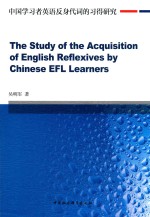

中国学习者英语反身代词的习得研究PDF电子书下载
- 电子书积分:10 积分如何计算积分?
- 作 者:吴明军著
- 出 版 社:北京:中国社会科学出版社
- 出版年份:2017
- ISBN:9787520301237
- 页数:227 页
Chapter One Introduction 1
1.1 Introduction 1
1.2 Referentiality in natural language 2
1.2.1 Referentiality in human language 2
1.2.2 Significance of the research on referentiality 4
1.3 Referential characteristics of reflexives in English and Chinese 7
1.3.1 Similarities in referential properties 7
1.3.2 Distinct referential characteristics 8
1.3.2.1 The difference in locality requirement 8
1.3.2.2 The difference in orientation 9
1.3.3 The logical problem with the acquisition of English reflexives 10
1.4 UG and second language acquisition 11
1.5 Organization of the dissertation 14
Chapter Two Theoretical Foundations:The Binding Theory 16
2.1 Introduction 16
2.2 Types of determiner phrases 17
2.3 The standard binding theory 19
2.3.1 Binding 19
2.3.2 Principle A of the standard binding theory 21
2.3.3 Problems with the standard binding theory 24
2.4 Modified versions of the standard binding theory 25
2.4.1 Binding Principle A of the parameterized approach 26
2.4.1.1 Governing Category Parameter and Proper Antecedent Parameter 26
2.4.1.2 Criticisms of the parameterized approach 28
2.4.2 Binding Principle A of the LF-movement approach 29
2.4.2.1 Account of the long-distance binding 30
2.4.2.2 Predictions for language acquisition 33
2.4.2.3 Problems with the LF-movement approach 33
2.4.3 Binding Principle A of the relativized SUBJECT approach 36
2.4.3.1 Binding Principle A 36
2.4.3.2 Long-distance effects 37
2.4.3.3 Subject orientation 39
2.4.3.4 Predictions for language acquisition 40
2.4.3.5 Problems with the relativized SUBJECT approach 41
2.5 The binding theory in the Minimalist Program(MP) 43
2.5.1 Overview of the MP:Simplicity 44
2.5.2 The phase theory 45
2.5.3 Mechanisms of binding in the phase theory 46
2.5.3.1 Derivational Binding Principle A 46
2.5.3.2 Binding through ?-feature matching 47
Chapter Three Previous Empirical Studies on Reflexives 49
3.1 Introduction 49
3.2 Studies on child language acquisition of reflexives 51
3.2.1 L1 research within the framework of the parameterized approach 52
3.2.1.1 Acquisition of reflexives with the local binding in the NL 52
3.2.1.2 Acquisition of L1 reflexives with LD binding 53
3.2.2 Reflexive and pronoun asymmetry 54
3.2.3 Evidence supporting the relativized SUBJECT approach 56
3.2.4 Developmental processes 57
3.3 Studies on second language acquisition of reflexive binding 60
3.3.1 Studies within the framework of the parameterized approach 60
3.3.1.1 Finer&Broselow(1986) 60
3.3.1.2 Finer(1991) 63
3.3.1.3 Thomas(1989 and 1991a) 65
3.3.1.4 Cook(1990) 66
3.3.1.5 Hirakawa(1990) 67
3.3.1.6 Eckman(1994) 68
3.3.1.7 Lakshmanan&Teranishi(1994) 68
3.3.2 Studies within the LF-movement approach 69
3.3.2.1 Christie(1992) 70
3.3.2.2 Thomas(1995) 70
3.3.2.3 Yip&Tang(1998) 71
3.3.2.4 Jiang(2009) 72
3.3.3 Studies within the relativized SUBJECT approach 73
3.3.3.1 Bennett(1994) 73
3.3.3.2 MacLaughlin(1998) 74
3.3.3.3 Wells(1998) 75
3.4 An alternative account of the problematic acquisition:the Interface Hypothesis(IH) 77
3.5 Summary 78
Chapter Four Experimental Design and Method 80
4.1 Introduction 80
4.2 The mixed RM ANOVA design 81
4.3 Procedure 83
4.4 Materials 83
4.4.1 Sentence Type 1:C-command 85
4.4.2 Sentence Type 2:Orientation 86
4.4.3 Sentence Type 3:Locality in the finite condition 87
4.4.4 Sentence Type 4:Locality in the nonfinite condition 87
4.4.5 Sentence Type 5:Locality in the PRNP condition 87
4.5 Participants 90
4.6 Research questions 91
Chapter Five Data and Data Analyses 93
5.1 Introduction 93
5.2 Preliminary analysis 94
5.2.1 The descriptive statistics 94
5.2.2 The results of the mixed RM ANOVA 98
5.3 Developmental patterns across binding properties 101
5.3.1 The low group 102
5.3.1.1 Aggregate results 102
5.3.1.2 Individual results 112
5.3.2 The mid group 119
5.3.2.1 Group data 119
5.3.2.2 Individual data 126
5.3.3 The high group 132
5.3.3.1 Group results 132
5.3.3.2 Individual data 139
5.4 Developmental patterns of binding properties through proficiency levels 145
5.4.1 C-commanding requirement 145
5.4.1.1 Aggregated data 145
5.4.1.2 Individual results 147
5.4.2 Orientation 149
5.4.2.1 Aggregated data 149
5.4.2.2 Individual results 150
5.4.3 Locality:The finite condition 151
5.4.3.1 Aggregated results 152
5.4.3.2 Individual data 154
5.4.4 Locality:The nonfinite condition 155
5.4.4.1 Aggregated results 156
5.4.4.2 Individual data 158
5.4.5 Locality:The PRNP condition 159
5.4.5.1 Aggregated results 159
5.4.5.2 Individual data 161
Chapter Six Discussion 163
6.1 Introduction 163
6.2 Main Results 164
6.2.1 Development across binding properties 164
6.2.2 Development through proficiency 165
6.3 Crosslinguistic influence 167
6.3.1 Positive transfer hypothesis 168
6.3.2 The two-stage transfer:Accounting for the group differences 169
6.3.3 Combinatory transfer of morphology of reflexives and AGR 170
6.4 Direct accessibility of Universal Grammar 171
6.4.1 L2 interlanguage grammars falling within the range sanctioned by UG 172
6.4.2 Constraints of UG on interlanguage grammars 174
6.4.2.1 The LF-movement account 176
6.4.2.2 The parameterized approach 177
6.4.2.3 The relativized SUBJECT analysis 177
6.5 Asymmetries in locality:A phase-based approach 179
6.5.1 Advanced L2 learners 180
6.5.1.1 Reflexives in the vP Phase 180
6.5.1.2 The DP phase 183
6.5.2 Intermediate L2 learners 184
6.5.3 Low proficiency learners 184
6.5.3.1 Completeness of the vP phase 185
6.5.3.2 Head of the phase:v vs.D 185
6.6 Interface categories involved in Binding Principle A 186
6.6.1 Acquisition of c-commanding condition:Pure syntax 187
6.6.2 Acquisition of locality in the nonfinite clause:Syntax-lexicon interface 188
6.6.3 Acquisition of locality in the PRNP condition:Syntax-semantics interface 190
6.6.4 Acquisition of the object DP binding:Syntax-discourse interface 192
Chapter Seven Conclusion 195
7.1 Introduction 195
7.2 Developmental patterns of L2 learners'acquisition of reflexives 195
7.3 Theoretical and empirical implications 196
7.4 Suggestions for future research 198
Notes 200
References 202
Appendix:Individual results 221
Abbreviations 226
- 《红色旅游的社会效应研究》吴春焕著 2019
- 《汉语词汇知识与习得研究》邢红兵主编 2019
- 《生物质甘油共气化制氢基础研究》赵丽霞 2019
- 《东北民歌文化研究及艺术探析》(中国)杨清波 2019
- 《联吡啶基钌光敏染料的结构与性能的理论研究》李明霞 2019
- 《异质性条件下技术创新最优市场结构研究 以中国高技术产业为例》千慧雄 2019
- 《《国语》和《战国策》词汇比较研究》陈长书著 2017
- 《中国制造业绿色供应链发展研究报告》中国电子信息产业发展研究院 2019
- 《行政保留研究》门中敬著 2019
- 《新课标背景下英语教学理论与教学活动研究》应丽君 2018
- 《小岛区块链》方军著 2020
- 《日本天智朝与东亚》(日)中村修也著;吴明浩译 2019
- 《面向可持续发展的马克思主义经济科学研究》刘正刚,李晓,田军著 2018
- 《冷战时代的中国战略决策》牛军著 2019
- 《排放权有偿使用定价》郭默,王金南,毕军著 2019
- 《敖汉“粟 ”源》朱佳,顾军著 2019
- 《民国十大悍将》王晓华,张庆军著 2019
- 《行测数学秒杀实战方法 2014》陈剑峰,马志斌,吴明主编 2013
- 《放养,让孩子像孩子那样成长》范晓军著 2019
- 《穿透式学习》方军著 2020
- 《红色旅游的社会效应研究》吴春焕著 2019
- 《中国当代乡土小说文库 本乡本土》(中国)刘玉堂 2019
- 《社会学与人类生活 社会问题解析 第11版》(美)James M. Henslin(詹姆斯·M. 汉斯林) 2019
- 《异质性条件下技术创新最优市场结构研究 以中国高技术产业为例》千慧雄 2019
- 《中国铁路人 第三届现实主义网络文学征文大赛一等奖》恒传录著 2019
- 《莼江曲谱 2 中国昆曲博物馆藏稀见昆剧手抄曲谱汇编之一》郭腊梅主编;孙伊婷副主编;孙文明,孙伊婷编委;中国昆曲博物馆编 2018
- 《中国制造业绿色供应链发展研究报告》中国电子信息产业发展研究院 2019
- 《中国陈设艺术史》赵囡囡著 2019
- 《指向核心素养 北京十一学校名师教学设计 英语 七年级 上 配人教版》周志英总主编 2019
- 《《走近科学》精选丛书 中国UFO悬案调查》郭之文 2019
